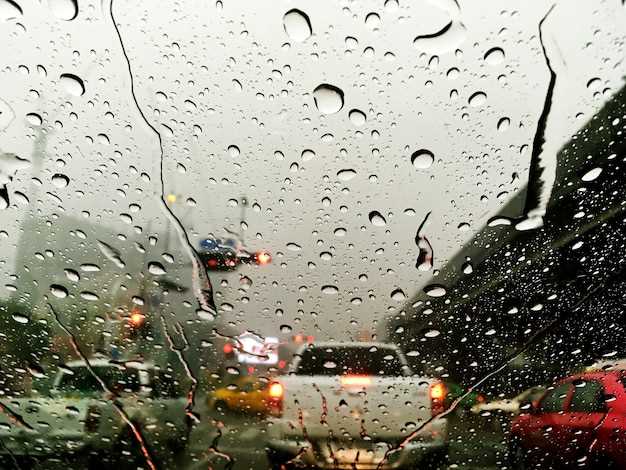
Driving in heavy rain can pose significant challenges and increase the risk of accidents. The combination of reduced visibility, slick roads, and potential flooding can lead to dangerous driving conditions. Understanding how to navigate these situations is essential for ensuring your safety and the safety of others on the road.
First and foremost, adjusting your speed is crucial. Rain can create a film of water on the road, which reduces tire traction, making it difficult to maintain control of your vehicle. It is important to reduce your speed to match the conditions; driving too fast for the situation can lead to hydroplaning. Furthermore, the posted speed limits may not always reflect safe driving conditions during heavy rain.
Visibility is another key concern when driving in heavy rainfall. To counteract this, ensure that your windshield wipers are functioning correctly, and consider using your headlights to improve visibility for both yourself and other drivers. Remember that in many regions, it is a legal requirement to use headlights during adverse weather conditions. Taking these simple steps can significantly enhance your awareness of your surroundings and help prevent accidents.
Adjust Your Speed and Following Distance

Driving in heavy rain necessitates a significant adjustment to your speed. Reduced visibility and slick road conditions can greatly affect your vehicle’s handling. It’s essential to slow down to maintain control and increase your reaction time to unexpected hazards. A common recommendation is to reduce your speed by at least a third of the posted limit, but always assess the conditions before determining a safe speed.
In addition to adjusting your speed, you must also increase your following distance. Under normal conditions, a three-second rule may suffice, but in heavy rain, consider extending this distance to five or more seconds. This buffer allows you ample time to react if the vehicle in front of you suddenly stops or if you encounter a hazard. Wet roads can lead to longer stopping distances, making it critical to provide adequate space between vehicles.
Moreover, be mindful of hydroplaning, which can occur at speeds as low as 30 mph if water accumulates on the road surface. Reducing your speed minimizes the risk of losing traction. Always remain aware that even minor changes in speed can drastically alter your vehicle’s stability in wet conditions. By adjusting both your speed and following distance, you greatly enhance your safety during heavy rain.
Utilize Headlights and Windshield Wipers Properly
Driving in heavy rain can significantly reduce visibility, making it essential to use your headlights and windshield wipers effectively. Proper utilization of these tools enhances safety on the road.
Here are some guidelines for using headlights:
- Turn on headlights: Always turn on your headlights during heavy rain to improve visibility for yourself and other drivers.
- Use low beams: Opt for low beam headlights as high beams can reflect off the rain and create glare, further reducing visibility.
- Fog lights: If visibility is extremely poor, use fog lights in conjunction with low beams to enhance illumination without creating excess glare.
- Check for functionality: Regularly inspect your headlights to ensure they are working correctly and replace any burned-out bulbs immediately.
Windshield wipers are equally crucial in maintaining clear visibility:
- Activate wipers: Set your windshield wipers to a suitable speed for the intensity of the rain. For light rain, a standard setting may suffice, while heavier downpours may require the highest speed.
- Regular maintenance: Inspect and replace windshield wiper blades regularly to ensure they are in good condition and capable of effectively clearing water.
- Use windshield washer fluid: Keep the washer fluid topped up and use it to clear away debris that may obstruct visibility, particularly during or after rain.
- Adjust for conditions: Adjust wiper settings based on changing weather conditions to maintain optimal visibility throughout your drive.
By following these instructions for headlights and windshield wipers, you can navigate heavy rain with increased confidence and safety, reducing the risk of accidents caused by low visibility.
Recognize and Avoid Hydroplaning Risks

Hydroplaning occurs when a vehicle’s tires lose contact with the road due to a layer of water between the tires and the pavement. This can lead to a loss of control, making it crucial for drivers to recognize the signs and take preventive measures.
To understand hydroplaning, it’s essential to know that it typically happens at speeds over 30 mph, particularly in heavy rain or standing water. Drivers should be aware of the conditions that increase this risk, such as worn tire tread, under-inflated tires, and smooth pavement surfaces. Regular tire maintenance is vital; ensure tires have sufficient tread depth and are inflated to the recommended pressure.
When driving in rainy conditions, keep your speed moderate. Reducing speed decreases the likelihood of hydroplaning, giving your tires a better chance to channel water away effectively. Moreover, avoid sudden braking or sharp steering movements, which can exacerbate the chances of losing traction.
Choose your driving path wisely. Stay in the tire tracks of vehicles ahead, as these grooves often have less water. When you notice standing water on the road, either steer clear of it or reduce speed to prevent hydroplaning. If you feel the vehicle start to hydroplane, resist the urge to swerve or brake abruptly; instead, gently release the accelerator and steer in the direction you want to go until your tires regain traction.
In summary, recognizing and avoiding hydroplaning involves monitoring your speed, maintaining your tires, and being mindful of road conditions. Taking these precautions can significantly enhance your safety during heavy rain conditions.





